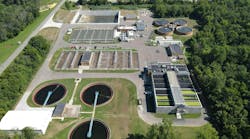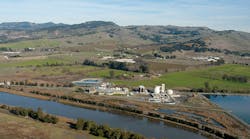Sara Myers is associate editor of WWD. Myers can be reached at [email protected].
- Location: Hollister, California
- Size: 4 million gal a day
- Infrastructure: Lift station, pump station, drip system, rotary drums, activated sludge belt press, chlorine disinfection & membrane bioreactor
At the Hollister Water Reclamation Plant in Hollister, Calif., safety is the plant’s number one concern. The plant, which is operated and maintained by Veolia North America, was recognized with the Safety Plant of the Year Award by the Monterey Bay section of the California Water Environment Assn. in March 2019.
According to Benito Link, a news website based in San Benito County, Calif., the plant has been recognized with other awards in recent years, including the Plant of the Year Award from CWEA’s Monterey Bay section in 2015 and 2017, and a Pacific Gas & Electric award for energy conservation efforts made by Veolia staff.
“Safety is number one for us and for all of Veolia,” said Jim Heitzman, Veolia project manager. “That comes from Bill DiCroce [CEO of Veolia North America] and John Gibson, who is the head of our division [COO of Veolia North America]. They fully support safety. All employees are empowered and we embrace safety here. That is a Veolia policy and it’s supported by senior management, and it works out really well because I believe if you’re safe, that’s the first fundamental that you need to have in order to have a good facility.”
According to Benito Link, the plant uses many safety policies and practices to ensure the highest standards are met, including safety tailgate meetings with employees, monthly training exercises, safety courses and the Safety First program empowering employees to act when safety issues take place.
“I believe all that stems from the fundamental of you’re going to be clean, you’re going to be safe,” Heitzman said. “It lends itself to be organized. We have daily meetings—five minute tailgate every morning. We have monthly meetings that we [talk] for 45 minutes. We have training and that just leads us to be professional.”
The plant is an membrane bioreactor (MBR) facility, and it has an activated sludge treatment facility. Heitzman said the plant does not have primary clarifiers. The facility workers manually remove rags and the plant has a 2 mm size limit on rags because the MBR uses hollow fiber membranes, so operators do not want the rags in the equipment.
“We have an activated sludge process and an MBR where we take our water, so it filters out the water. It then goes through chlorine disinfection, and it is either put out in house or put on parks or it’s put on agriculture,” Heitzman said.
Hollister provides reclaimed water to farmers who grow table crops in the surrounding area. The process of using the reclaimed water for them has been going on for three or four years, Heitzman added.
“It is a common practice in California. We’re a big agricultural community,” he said. “The water they do not use—such as in the winter time when they’re not growing—they end up putting in the ground for
groundwater replenishment.”
The plant has faced many challenges including retaining maintenance and operations operators, as the Baby Boomer generation is retiring. Another challenge has been getting the reclaimed water system online for the growers.
“It was new and we had to work out the bugs,” Heitzman said. “But mostly, the team has done a great job. It’s an awesome team here. There’s only a six employees, but they’re all hard working and happy.”
The team replaced the rotary drums in house, which Heitzman said was a big job. Additionally, the plant has an operator in the training program with in San Benito County.
“The amount of training that goes in there can be challenging,” Heitzman said. “But, we have a great plan. Our operator’s name is Jose Rodriguez and he’s got energy and he just loves getting people trained and in our field. Challenges are looked at more as an opportunity.”



